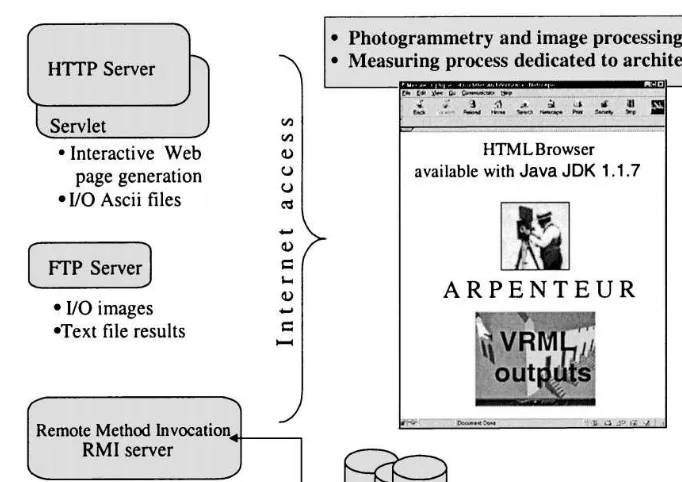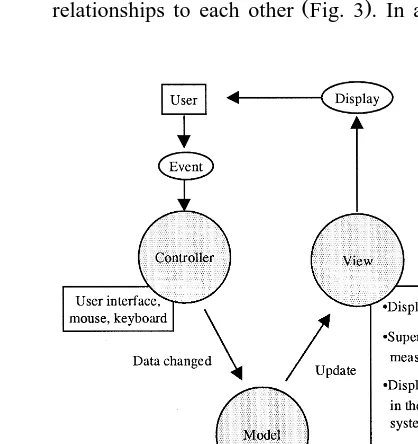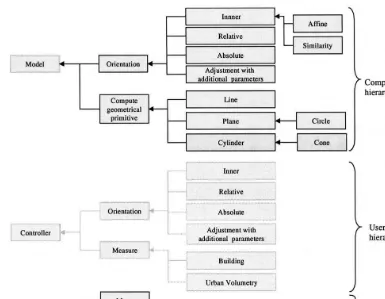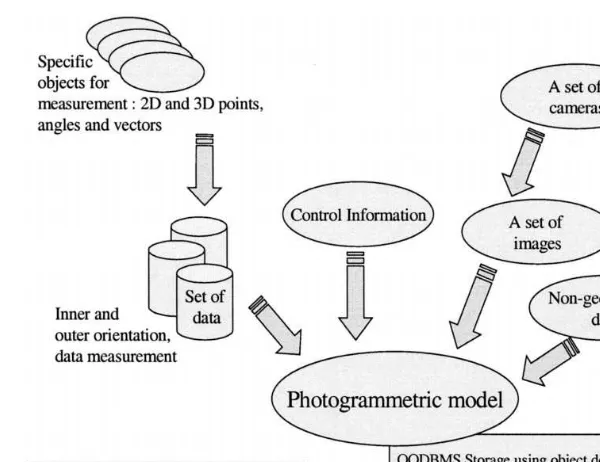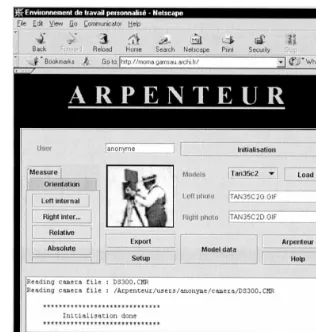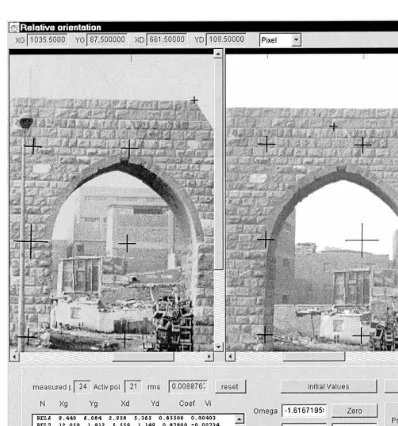www.elsevier.nlrlocaterisprsjprs
A digital photogrammetric workstation on the WEB
qP. Drap
a, P. Grussenmeyer
b,)a
GAMSAU UMR CNRS 694, Ecole d’Architecture, 184 AÕenue de Luminy, Marseille F-13288, France
b
ENSAIS-LERGEC, 24 BouleÕard de la Victoire, Strasbourg Cedex F-67084, France
Received 1 December 1998 ; accepted 21 December 1999
Abstract
The main features of a WEB-based tool for digital architectural photogrammetry called Architectural Photogrammetry
Ž .
Network Tool for Education and Research ARPENTEUR are presented. The aim of this project is to propose a photogrammetric software package made freely available on the Internet as an applet through a simple browser Žhttp:rrwww.arpenteur.net . All the photogrammetric adjustment and image processing classes are written in Java. e. The use of large applets in photogrammetry has not been very advanced until now but rate transfers and compatibility levels of Internet browsers will increase in the near future. Users can set up their own projects by transferring their images, camera, and control information on the ARPENTEUR servers from any place in the world connected on the Internet. Various examples of small format architectural photogrammetry projects are also accessible via WWW and can be used for teaching.
Ž .
This software is an extension of the Traitement d’Images et Photogrammetrie Numerique TIPHON software developed at´ ´ ENSAIS-LERGEC. The photogrammetric model is currently computed by the traditional steps of inner, relative and absolute orientations. The measurements in the images can be performed manually or by image correlation. The measured points, lines, and geometrical primitives are recorded in text files and visualised inside a standard WEB browser. The plotting module is especially dedicated to architectural surveys and based on a formalisation of architectural and geometrical knowledge. The latest developments of the Java programming language and object-oriented systems are used in ARPEN-TEUR, both in the photogrammetric and in the architectural part, and ensure a high level of compatibility with any hardware platform supporting a WEB browser.q2000 Elsevier Science B.V. All rights reserved.
Keywords: digital photogrammetry; object-oriented technology; Javae; knowledge representation; WEB technology; education; architecture
1. Introduction
Most of the photogrammetric applications are used locally on individual computers and each application
q
Revised version of a paper presented at the ISPRS Commun. V Symp., June 2–5, 1998, Hakodate, Japan.
)Corresponding author. Tel.: q33-3-8814-4733; fax: q 33-3-8824-1490.
E-mail address: [email protected]
ŽP. Grussenmeyer ..
has to be installed separately. Some packages are operational within local networks or workgroups. The idea developed in the Architectural Photogram-metry Network Tool for Education and Research
ŽARPENTEUR project is to propose a photogram-.
metric software package made available on the
Inter-Ž .
net as an applet Fig. 1 through a simple browser. This project is managed by two French research
Ž
groups located in Strasbourg ‘‘Photogrammetry and
.
Geomatics’’ group at ENSAIS-LERGEC and in
Ž .
Marseille Gamsau-MAP CNRS laboratory . In
pho-0924-2716r00r$ - see front matterq2000 Elsevier Science B.V. All rights reserved.
Ž .
( )
P. Drap, P. GrussenmeyerrISPRS Journal of Photogrammetry & Remote Sensing 55 2000 48–58 49
Ž .
Fig. 1. ARPENTEUR’s project synoptic scheme, from Drap et al. 1999 .
togrammetry, the use of applets available on the Internet instead of local applications is, in most cases, not advanced. Applets are, most of the time, just used either to present examples on the Internet or to show methods of data processing. An interest-ing applet presentinterest-ing image matchinterest-ing of reseau
´
Ž .
crosses has been presented by Hohle
¨
1998 . As another example, national mapping agencies often use applets for the computation or the transformation of geodetic coordinates.Our research is motivated by different reasons. Ø Software for education and research: developing
software using Javae is particularly convenient,
when teams working in several places use
differ-Ž
ent platforms here Windows NT and Unix
plat-.
forms located in Strasbourg and Marseille . Ø A WEB tool dedicated to architectural survey:
ARPENTEUR has the benefit of the two partners’ laboratory expertise in the field of close-range photogrammetry and architectural knowledge rep-resentation in a survey process. This collaboration is enriching for both researchers and students working on the project.
Ø A simple photogrammetric system for archaeolo-gists, architects and photogrammetists available
wherever they are in the world. As an example, the members of International Committee for
Ar-Ž .
chitectural Photogrammetry CIPA can benefit from the use of a digital photogrammetric work-station on the WEB for simple projects and pre-sentation of examples on the ARPENTEUR servers.
The purpose of the paper is to present the archi-tecture and the capabilities of ARPENTEUR based on the latest developments of Java programming language and object-oriented systems.
2. The use of object-oriented technologies
2.1. Object-oriented technologies and knowledge representation
The strategy developed for ARPENTEUR, both in the photogrammetric development and in the archi-tectural approach, is directed by data-processing ob-ject-oriented languages regarding the formalisation of complex knowledge fields.
reason-ing by classification. The universe of knowledge can be divided into elementary objects structured by specialisation of properties. With this approach, we can model complex phenomena by the description of the relations between the various objects and reach a high level of abstraction. The object-oriented pro-gramming languages give an opportunity to for-malise and handle models of complex knowledge fields. The field of knowledge is split into elemen-tary concepts, structured through refinements of
Ž .
classes Oussalah et al., 1997 .
2.2. The JaÕa enÕironment
The programming language chosen for the AR-PENTEUR software is Java. There are at least two reasons for this choice:
Ø Java is strongly object-oriented; and
Ø Java is a platform-independent programming lan-guage supposed to run anywhere and supported by a lot of Internet browsers.
Java is a recent language, based on OAK devel-oped by Grosling at SUN in 1991. OAK was an object-oriented language and platform-independent. In 1995, OAK became Java by addition of Internet capabilities. Java is given by SUN to the Internet community with its compiler, library, specifications, and documentation. The code written in Java is compiled in order to produce byte-code, which is a low-level format. This resulting code is transferred locally during the loading of the applet and inter-preted on each different hardware by the Java Virtual Machine. For each computer, the Java Virtual Ma-chine will be different, that is why Java is indepen-dent of platform.
( )
2.3. The Model–View–Controller MVC paradigm
Building a modular object-oriented user interface is a very hard task. The result is difficult to maintain, complex to understand, and often not reusable. How-ever, there is a lot of benefit to separate the user interface from the application code. This kind of separation in an object-oriented context is often made using the MVC method. The MVC, originated in Smalltalk, is used in many different contexts. Java,
with its event delegation model, allows us to use it in
Ž .
this application Fig. 2 . The advantages of this approach allow:
Ø a methodical approach of Graphical User
Inter-Ž .
face GUI design;
Ø an independent development of application com-Ž
ponents more than one programmer at the same
.
time is possible ;
Ø the reusability of the application and the user interface components; and
Ø an easy development of new features.
In this context, independence between interface and model means that different interfaces can be used by the same application. This means that the application does not know which interface is cur-rently connected to it. Similarly, any part of the system can be changed without causing any distur-bance to the others.
2.4. The photogrammetric objects
The photogrammetric universe is modeled as an organisation of concepts in different hierarchies and
Ž .
relationships to each other Fig. 3 . In addition, the
( )
P. Drap, P. GrussenmeyerrISPRS Journal of Photogrammetry & Remote Sensing 55 2000 48–58 51
Fig. 3. The hierarchy of the MVC objects.
taxonomy of the MVC components allows the opera-tor to navigate in the system. Under these conditions, writing software is equivalent to describing the rela-tions between the different objects as, e.g., the pho-togrammetric model which knows its image, which knows its camera, and so on.
3. Object-oriented database management system
3.1. Description of network database process archi-tecture
ARPENTEUR uses an Object-Oriented Database
Ž .
Management System OODBMS which provides an
Ž .
Application Programming Interface API for storing and sharing Java objects among users, hosts, and programs. The user can modify a subset of his own
Ž
data through the network e.g., update a
measure-.
ment in the relative orientation process . The object
storage is made on the server and monitored by a
Ž .
Remote Method Invocation RMI Java Server di-rectly connected with the local client. This RMI server, which allows the objects to move across the network, is the interface between local objects avail-able on the client computer and the database located on the main server.
3.2. Managing objects with an OODBMS
The object storage management used in ARPEN-TEUR is performed by the OODBMS and has one distinctive feature: the programming language is the same as the language used to manage the data. That means that there is no difference between describing
Ž .
a system the photogrammetric process in our case using an object-oriented approach in Java and elabo-rating the database scheme.
Fig. 4. ‘Part-of’ dependency for object storage.
describe the photogrammetric process are dependent on each other; e.g., in Fig. 4, the ‘photogrammetric model’ object uses a set of ‘images’ which uses a camera model and so on. The object-oriented ap-proach guarantees that saving a model also means saving all its dependencies and, in addition, saving a part of a model, i.e., a new measurement in an orientation phase is made by a simple update without re-storing all model data.
4. A digital photogrammetric tool on the WEB
The photogrammetric approach is based on
well-Ž .
known algorithms Kraus, 1997a,b used in the Traitement d’Images et Photogrammetrie Numerique
´
´
ŽTIPHON. software ŽGrussenmeyer and Koehl, .
1998 . The standard steps include inner, relative and absolute orientation. ARPENTEUR is developed in Java, using JDK 1.1.7, and is operational from any hardware platform supporting a WEB browser using this level of Java. Presently, the software is tested with Netscapee Communicator 4.51 on PC and
Netscape Communicator 4.6 on SUN workstations.
4.1. Internet access
The software is accessible via the Internet
net-Ž .
work and a WEB browser Fig. 5 . We use three kinds of servers to offer various services. Using ARPENTEUR means three steps.
4.1.1. HTTP serÕer
Ž
The HTTP server and the servlet module a servlet module runs inside requestrresponse-oriented servers, and provides a way to generate dynamic
.
html documents allow the creation of a workspace by a registration page. The user has access to an
Ž
example project about an aqueduct in Cairo
Grus-.
senmeyer and Abdallah, 1997 . Once a user has registered, he has free access to the whole capability of ARPENTEUR.
4.1.2. FTP serÕer for the use of ARPENTEUR with
an own project
( )
P. Drap, P. GrussenmeyerrISPRS Journal of Photogrammetry & Remote Sensing 55 2000 48–58 53
Fig. 5. ARPENTEUR’s main frame.
workspace, so he can put images, camera definition files, and ground control point files on the server and get the output text files generated by the system.
4.1.3. RMI serÕer
ARPENTEUR is an applet using a lot of Java classes. That means that the process is running on the client computer; the Java security restrictions do not allow an applet to read or write files on the client disk. To solve this problem, we have developed a Java application server, running on the server ma-chine and dedicated to saving files on the server disk and managing objects through the network using the RMI method. Each connected client has his own RMI server to ensure data integrity. Thus, all files
Žcamera, control points, etc. and images of each.
project are stored on the server, but are
password-protected, such that only the user and the system administrator have access to them. To solve local access problems, we are working on another version to be used on an Intranet network.
Two servers located in Marseilles and Strasbourg are currently dedicated to this project. Due to storage limitations, the image size is currently limited to 2 MB. All the result files, the orientation reports, and the plotting files are written in the user workspace on the server by this Java application server after con-nection with the client.
4.2. The photogrammetric functions
4.2.1. Orientations
The photogrammetric development follows the
Ž
Grus-.
senmeyer et al., 1998 . In addition to the standard
Ž .
orientation Fig. 6 steps on analytical or digital stereoplotters, we also propose an absolute orienta-tion made without control points. We define a local coordinate system by measuring particular points on
Ž .
the model vertical lines, wall corners , and a scaling of the model by measuring some distances on the object. The goal is to provide an easy-to-use pho-togrammetric software package, allowing also simple
photogrammetric surveys with non-metric cameras and without theodolite.
4.2.2. Measuring points
For point measurement, we use image correlation
Ž
in the inner orientation e.g., automatic measurement
.
of reseau crosses and also for the measurement of
´
Ž
homologous points during the outer orientation and
.
the plotting process . The used method is a
combina-Ž .
( )
P. Drap, P. GrussenmeyerrISPRS Journal of Photogrammetry & Remote Sensing 55 2000 48–58 55
tion of the maximum correlation coefficient and
Ž
correlation in the subpixel range Hohle, 1997; Kraus,
¨
.
1997a,b .
4.2.3. Geometrical tools
In order to propose a photogrammetric tool dedi-cated to architecture, we added some geometrical tools to manage point measurement on geometrical
Ž .
primitives Florenzano et al., 1997 . A set of least square computation models is available like compu-tation of lines, planes, circles, and cylinders using 3D measured points on their surface.
4.3. Graphical and text output results
The results of all orientation steps are recorded in an ASCII file. Therefore, it is often difficult to have a good visualisation of numerical results just by looking at numbers. To represent the 3D data gener-ated by the model computation, we use the 3D file
Ž .
format of MicroStation Bentleye. We also
devel-oped a set of routines able to write geometrical information in this file format. Thus, at each orienta-tion step, we create a file in this format directly readable by the MicroStation software. For example, after the inner orientation of a reseau camera, the
´
system generates automatically a DGN file, which represents the discrepancies between theoretical val-ues of the reseau and measured crosses. A scale
´
factor is computed to represent the discrepancies as visible vectors on the screen. If the client does not use MicroStation, he can get the results in the ASCII files or use the Virtual Reality Modeling Language
ŽVRML output see Section 4.4 .. Ž .
4.4. VRML output
VRML is a platform-independent interpreted lan-guage dedicated to the visualisation of 3D scenes inside a standard WEB browser. All objects manipu-lated by ARPENTEUR which implement a VRML interface are enabled to visualise their instance cre-ated through the survey process. This allows a direct monitoring of the scene from within the applet. Measured points, controls points, geometrical primi-tives, and architectural objects can therefore be
visu-Ž
alised during the successive steps of the survey once
.
the absolute orientation is done . JavarVRML
inter-action is used in order to allow the user to retrieve data from an object in the scene by a mouse click on its VRML representation. We are also working on a Java visualisation tool avoiding the installation of an additional VRML plug-in in the browser.
5. Present problems with Java and internet
The use of Java and the WEB platform is full of advantages and promises. Distributing software on any platform at any place connected to Internet is, of course, very interesting. The updating is done di-rectly on the server and the user always works with the latest release of ARPENTEUR. But presently, we have to deal with three delicate points by proposing ARPENTEUR on Internet.
5.1. Loading time
This software architecture is based on client– server relation: the software is loaded through the network and runs on the client computer. The load-ing time can be important; the software itself is a large file and the loading time also depends on the data size since all data, and especially image files, are stored on the server. In addition, the data transfer rate on the network is not regular. Therefore, once the files and images are loaded on the remote com-puter, the use of the disk cache makes it possible to work properly.
5.2. Instability of programming language
Java is a recent language in constant updating. We always choose to work with the latest versions
Žcurrently JDK 1.1.7 but this leads to some prob-.
lems.
Ø The compiler is not stable and a lot of bugs still exist.
and its diffusion around Internet to improve this point.
Ø Presently, all the Java Virtual Machines are not at the same level, so it is possible that some func-tions do not run on certain platforms.
Ø Since the first version of ARPENTEUR presented at the ISPRS Commun. 5 Symposium in
Hako-Ž .
date Drap and Grussenmeyer, 1998 , we have chosen the strongly MVC-oriented Swing API provided by Sun.
Ž . Ø We plan to use the latest version of JDK 1.2 at
the beginning of 2000. Working with a newer version of Java is more comfortable for develop-ing software; therefore, it poses restrictions on the software use. Actually, the Internet browsers do not run with the Java Virtual Machine 1.2 and the future users will have to first download the neces-sary Java plug-ins from SUN before using the ARPENTEUR applet.
5.3. Execution time
Java is compiled in byte-code, then interpreted by the Virtual Machine. This allows multiple computers running the same software but increases the execu-tion time, since the applet is running within the browser. Presently, executing software in Java takes 10 or 20 times longer than in Cq q native code.
Ž .
Just-In-Time JIT compilers, which are faster, are not possible with ARPENTEUR that has to be used with the Java Virtual Machine of the browser. This is a problem for computer-intensive operations like im-age processing. This situation may be improved in the future.
6. Perspectives: a photogrammetric tool dedicated to architecture
The ARPENTEUR project is relatively new. The development started at the end of 1997 and now a version of a standard photogrammetric process is
Ž .
available Grussenmeyer et al., 1999 . We organise our future work in three directions:
Ø to increase the reliability and interface user-frien-dliness of the photogrammetric tools;
Ø to add photogrammetric functions in the
orienta-Ž .
tion process i.e., bundle adjustment ; and Ø to develop a tool dedicated to architectural
sur-vey.
6.1. The photogrammetric software
We are working on improving the photogrammet-ric software performance, the didactical reports, the speed, and the robustness of algorithms. The use of Internet as an access platform will enable us to offer multi-language access to ARPENTEUR. In 2000, English, Italian and Spanish versions will be avail-able. The ARPENTEUR project, presently managed by ENSAIS and GAMSAU, can accept in the future other contributions from the international commu-nity. As an example, the kernel of the Java visualisa-tion tool recently implemented is a contribuvisualisa-tion of T.
Ž .
Landspurg Landspurg, 1999 .
6.2. A tool dedicated to architectural surÕey
Our first objective is to dedicate the plotting module to architectural applications. This module is based on a formalisation of architectural and geomet-rical knowledge. The architectural measured object must be first identified and structured. Then, the architectural knowledge is used to guide and control the measuring process of a building. This means that the morphology of the measured object is already
Ž .
known Florenzano et al., 1997; Drap et al., 1999 . Elements of a building are described as ‘‘entities’’
Želementary objects providing that they meet two.
requirements:
Ø an entity is a unique ‘‘object’’ identified by a single element of the architectural vocabulary; and
Ø an entity has an obvious and permanent role in the physical structure of the building.
The benefit of a tight link between knowledge and measurements will appear at several levels:
( )
P. Drap, P. GrussenmeyerrISPRS Journal of Photogrammetry & Remote Sensing 55 2000 48–58 57
Ø The photogrammetric tool allows the user to both validate a structural architectural model and study any surface alteration.
The use of an object-oriented approach allows us to increase the set of architectural entities available in the system. Actually, this phase requires the knowledge of Java programming, but this operation should be able to be performed by a user without high computer science knowledge. To solve this problem, we are currently developing an additional tool named ‘‘Classeur’’ able to generate Java source regarding a textual definition of a new entity. This tool will compile the source on the server and load the new class on the client computer. This develop-ment will give a dynamic aspect to the system.
7. Conclusions
ARPENTEUR is presently accessible via Internet
Žhttp:rrwww.arpenteur.net and allows basic pho-.
togrammetric functions like inner and outer orienta-tions and different survey funcorienta-tions. This project, which only started at the end of 1997, will be improved by the extension of a photogrammetric software library to offer our students and researchers a development platform and tools for their projects combining photogrammetry, computer science, archi-tecture, and archaeology. We try to use the advan-tages of the interdisciplinary context of our project to develop a photogrammetric tool dedicated to archi-tectural survey. Presently, ARPENTEUR is used for teaching photogrammetry with small-format images to students at ENSAIS and GAMSAU. Even if the use of large applets on Internet is not always easy, we are confident in the future of Java and Internet and hope that rate transfers and efficiency of per-sonal computers, as well as the compatibility levels of Internet browsers, will increase soon to make such a project a realistic one. Finally, we think that this project will meet the CIPA objectives by offering this community a free photogrammetric tool for sim-ple projects. The integration of architectural knowl-edge into the software is in accordance with the paradigm of architectural survey: increasing knowl-edge in surveying so that surveying might broaden our knowledge.
Acknowledgements
Ž .
The authors wish to thank P. Capron Strasbourg
Ž .
and G. Gaillard Marseille for their contribution to the development of the ARPENTEUR software package in 1999 during their postgraduate studies at ENSAIS and GAMSAU.
References
Drap, P., Grussenmeyer, P., 1998. ARPENTEUR, an architectural photogrammetry network for education and research. In: Proc. ISPRS Commun. V Symp., Hakodate, Japan. Int. Arch. Pho-togramm. Remote Sens. Vol. 32 pp. 537–542, Part 5. Drap, P., Grussenmeyer, P., Blaise, J.-Y., 1999. A
photogrammet-ric survey using knowledge representation on the ARPEN-TEUR WEB-based photogrammetric workstation. In: Proc. XVII CIPA Int. Symp., October 3–6, Olinda, Brazil. Int.
Ž . Ž .
Arch. Photogramm. Remote Sens. 32 5C2 in print . Florenzano, M., Blaise, J.-Y., Drap, P., 1997. Photogrammetry
and knowledge representation. A restitution of archaeological hypothesis on the Bigot model of ancient Rome. In: Proc. CIPA Symp., Goteborg, Sweden. Int. Arch. Photogramm.¨
Ž .
Remote Sens. 32 5C1B pp. 90–96.
Grussenmeyer, P., Abdallah, T., 1997. The cooperation in
archi-Ž .
tectural photogrammetry between ENSAIS France and ECAE
ŽEgypt : practical experiences on historic monuments in Cairo..
In: Proc. CIPA Symp., Goteborg, Sweden. Int. Arch. Pho-¨
Ž .
togramm. Remote Sens. 32 5C1B pp. 215–221.
Grussenmeyer, P., Koehl, M., 1998. Architectural photogramme-try with the TIPHON software, towards digital documentation in the field. In: Proc. ISPRS Commun. V Symp., Hakodate,
Ž .
Japan. Int. Arch. Photogramm. Remote Sens. 32 5 pp. 549–556.
Grussenmeyer, P., Morot, C., Goujon, Y., 1998. TIPHON: un logiciel de photogrammetrie numerique developpe a l’EN-´ ´ ´ ´ `
SAIS. Revue de l’Association Franc¸aise de Topographie 75, 61–66.
Grussenmeyer, P., Drap, P., Koehl, M., Blaise, J.-Y., 1999. TIPHON and ARPENTEUR: simple photogrammetric soft-ware packages for stereoplotting. In: ISPRS Commun. Vr5 Vr2 Int. Workshop, Thessaloniki, July 7–9, Greece. Int.
Ž .
Arch. Photogramm. Remote Sens. 32 5W11 pp. 51–57. Hohle, J., 1997. The automatic measurement of targets. Pho-¨
togrammetrie, Fernerkundung, Geoinformation 1, 13–21. Hohle, J., 1998. Computer-assisted learning and teaching on PCs¨
and the Internet. In: Proc. 21st Int. Congr. FIG, Brighton, UK, Commun. 2, pp. 124–135.
Kraus, K., 1997a. In: Photogrammetry, Vol. 1. Fundamentals and Standard Processes. Translated by P. Stewardson, Dummler,¨
Kraus, K., 1997b. In: Photogrammetry, Vol. 2. Advanced Method and Applications. Translated by P. Stewardson, Dummler,¨
Bonn, with contributions by J. Jansa and H. Kager . Landspurg, T., 1999. JView3D: a 3D Java viewer. http:rr
visualbeans.comrView3Dr, accessed December 16, 1999. Oussalah, C., Andre, P., Blay-Fornarino, M., Boulanger, D.,´
